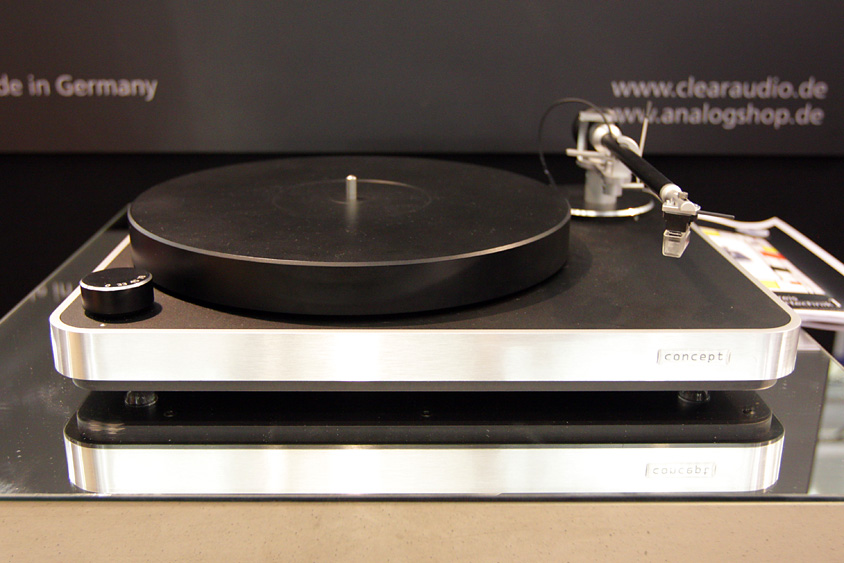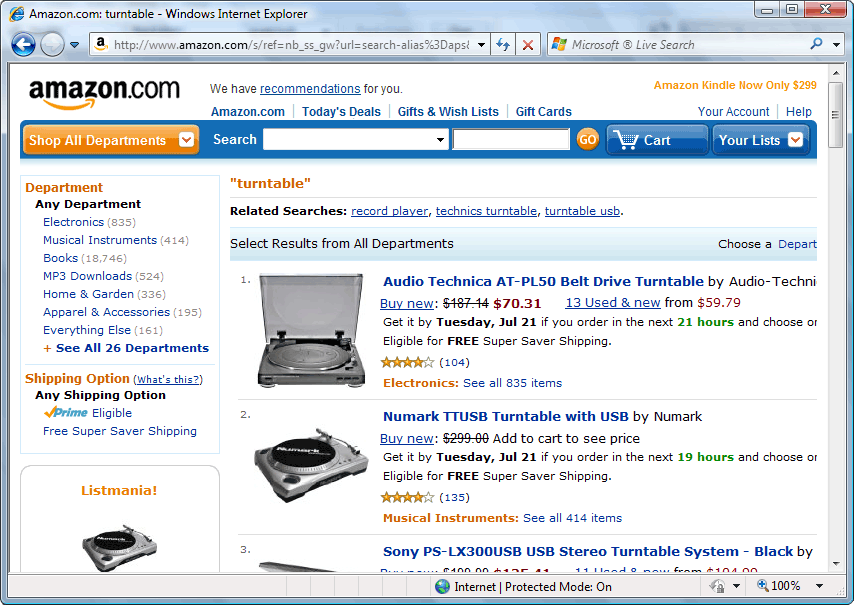 August 2009
The Pros and Cons of LPs Today
If you’re reading this article,
you’ve likely read many others about the resurgence of the vinyl LP. On one side are
the diehard vinyl enthusiasts who think digital has run its course and we’re finally
returning home. On the other side are those who think that a few more slabs of black
plastic aren’t much when compared with the millions of downloads available from
iTunes. This article is not likely to please partisans of either camp. Rather, it seeks to
be a balanced assessment of the current vinyl marketplace, and to help you decide whether
to get into vinyl, if you aren’t already.
Equipment
While the SoundStage! Network publishes
reviews of audio recordings, it’s primarily concerned with the equipment used to
reproduce those recordings. When it comes to the components needed to play LPs --
turntables, tonearms, cartridges, phono stages, etc. -- many models are available at all
price points. There are more choices now than there were a decade ago, but turntables,
from the reasonably to the unreasonably priced, have always been available. For more
specific component information and recommendations, you should browse the equipment
reviews on SoundStage! and our sister sites. So long as you avoid the very cheapest
’tables put out by the mass-market brands, a satisfying musical experience can be had
for not much money. You may be tempted to buy used equipment from a thrift store, but the
vast majority of such items will not have been of high quality to begin with, and may have
deteriorated with neglect or misuse. I wish you happy hunting, but you have been warned!

German manufacturer Clearaudio recently debuted their
least-expensive turntable yet, the Concept. Shown at High End 2009 in Munich, Germany, the
Concept is said to be priced at €995 (about $1400 USD), complete with tonearm and
cartridge.
Used vinyl
No matter how many articles are written about new vinyl,
those releases amount to a very short stack next to the mountains of used albums out
there. While I caution readers against searching thrift shops and garage sales for
equipment, such places remain excellent sources of used vinyl -- you can walk away with a
back-breaking haul for little money, and sometimes for no money at all. I’ve made
some worthwhile finds by grubbing through bins, but even a careful examination of the
condition of what you’re buying won’t guarantee sonic nirvana. I estimate that
only one out of every ten LPs I buy at garage sales has little enough surface noise and
distortion to count as high-fidelity -- and even that ratio is after I’ve
cleaned every one of them with a vacuum record-cleaning machine. Of course, at 25¢ or
50¢ per disc, one out of ten is still a good deal.
Old music -- new vinyl
Most of the talk revolving (pun intended) around the vinyl
resurgence centers on the availability of new pressings. As with equipment, there is
somewhat more new vinyl available now than there was 10 to 15 years ago, but not
dramatically more. What’s more significant is that it’s now available through a
wider variety of retail channels. A decade ago, new vinyl was available only at shops or
websites catering to audiophiles or DJs -- I can’t conceive of a single shop catering
to both, but it might exist. Now even Amazon.com has a modest vinyl store. The music
that’s available breaks down into a few main categories.

Amazon.com now sells turntables and LPs!
Combing the catalogs of the principal mail-order houses,
one gets the impression that the vinyl reissues of greatest importance to audiophiles are
those of recordings from the 1950s, ’60s, and ’70s. Many of these recordings
have been meticulously remastered and cut, then stamped on biscuits of high-quality virgin
vinyl. Most of these pressings sound very good, and some sound extraordinary. They also
carry hefty price tags of $30 and up. As for the music itself, many popular groups from
those decades are represented. This period also comprises what many people, me included,
consider to be the golden age of jazz. One can find new pressings of all major artists,
though certainly not of every one of every artist’s albums. Many classical music
recordings are also available, though these, too, tend to be only of major artists and
orchestras, major labels, and well-known works.
Non-audiophile re-pressings of older material are
also available. Most of these releases tend to be of popular music, with some jazz thrown
in. Rarely does one see a standard-weight (120-150gm) reissue of a classical recording.
Some of these albums are aimed at the DJ market, but many are intended for baby boomers
who long ago sold or threw away their old vinyl and now want to get back to analog.
Younger consumers, too, are buying some of these reissues, and I suspect that it’s
this sort of release that makes up the bulk of vinyl sales. Audiophiles should be wary of
such releases. Some can sound very good, but many are pressed more for nostalgic than
sonic reasons, and can have substantial surface noise and other imperfections that cause
them to compare poorly to the same album on CD.
New music
Increasingly, recently recorded music is being released on
vinyl. Groups from Alison Krauss + Union Station to Radiohead and Nine Inch Nails have
made high-quality pressings available shortly after the initial CD release. Even more
groups, particularly indie rock bands, have made albums available on pressings of variable
quality. The prices of such new releases vary from the same price as the CD to many
multiples of that cost. The most expensive offerings are often pressed on high-quality
vinyl and have elaborate artwork and packaging.
Some modern jazz releases are available on vinyl.
Primarily, these are recordings of lesser-known artists on small audiophile labels. The
sonics of such recordings are often first-rate, and they can introduce you to new artists
with great musical talents. I even have a few such recordings for which a CD is not
available -- at least in the US.
Classical music is quite a different story. Recently a
reader wrote to me, looking for new classical releases on vinyl. I wish I had better news
for him, but my own search has not been fruitful. Of all classical recordings made in the
last decade, a mere handful are available on vinyl. However, classical music labels,
particularly the smaller ones, have by no means ignored the audiophile community. A great
many new releases are on hybrid SACD/CD, and others are available as high-resolution
downloads. However, the classical music lover can be forgiven for thinking that vinyl is
really and truly dead.
The sound comparison
To me, jazz and popular music can be grouped together
insofar as the uniqueness and identity of a recording. If I want to hear Miles
Davis’s Kind of Blue, Columbia/Sony has made it available in every recording
format of the past half-century. The original recording is still the same, with perhaps
some slight retouching. The same could be said of the Eagles’ Hotel California,
or any other song or album. It is therefore sensible to compare the sounds of different
distribution media -- e.g., vinyl and CD. The most perfect sound is that which is
on the master tape. One can simply choose as "best" the medium that most closely
approximates that sound.
Again, classical music should be considered under a
different paradigm. You may be interested in a particular artist or a particular
performance. In those cases, classical is no different from jazz or pop. But in many cases
a classical listener is interested in a particular musical work of which many recordings
exist. Though there are many things I love about the sound of vinyl, it is exceedingly
rare to find a classical recording on vinyl that can compete, on the basis of realistic
sound, with a modern digital recording on SACD or even CD.
The digital LP
Beginning in the late 1970s, many sound engineers began to
record, mix, and edit digitally. The primary reason for the switch was convenience.
Although early digital workstations were not as streamlined as those used today, they cut
down greatly on the laborious task of cutting and splicing recording tape. Many record
labels took advantage of the high-tech appeal of digital, and began to market their vinyl
releases as digital in the same way that they had touted stereophonic and
other supposed advancements over the years. While digital recordings had the distinct
technical advantage of a much lower noise floor, the modest bit depths and sampling
frequencies then used resulted in sound that was in most other ways inferior to that of
analog tape. Those factors, combined with the necessary reconversion from digital back to
analog, explain why most of these early digital LPs sound awful.
Most new recordings released on vinyl were also recorded
digitally, but the LP editions can still sound very good. Modern 24-bit/96kHz recordings,
or occasionally DSD, are a far cry from early digital recordings, some of which were
recorded at resolutions as low as 12-bit/30kHz. Listening through my system, I can still
identify which LPs were recorded digitally, and which remained entirely in the analog
domain, from microphones to vinyl. The digital recordings seem to lack a little of the
ease and flow that I love about analog reproduction. That said, they can sound very good
in their own way. If the audiophile’s goal is to come as close as possible to the
sound of the original signal, then the fewer conversions that occur throughout the chain,
the better. If a recording was made digitally, I’d rather listen to it from a digital
source. If it was made and mixed entirely in the analog domain, I’d rather play it
back that way.
Conclusion
Vinyl is not mainstream, and probably never will be again.
Fortunately, some artists, labels, and stores still think it has something to offer. So
long as there are consumers willing to buy them, vinyl LPs will be available. Whether
vinyl is right for you, as a music listener and audiophile, will depend a great deal on
the type of music you like and what you expect to get from the experience of listening to
recordings of it. I probably listen to more digital than analog, but the best sound
I’ve heard in my system still comes from vinyl. To me, what a good LP has to offer is
worth the trade-offs.
. . . S. Andrea Sundaram
s_andrea@soundstage.com
|

